
I have mentioned NYC’s major tunnels only tangentially in Forgotten New York. Over more than 20 years, the site has become about NYC’s built infrastructure (at least the parts I find interesting) as much as it has the parts of NYC that are overlooked or “forgotten.” and, personally, I have a tangential relationship with its tunnels. I have the most experience with the Brooklyn-Battery (or Hugh Carey Tunnel, as the Democratic Party-dominated state enjoys renaming bridges and tunnels for deceased Democratic politicians: the public ignores these names, and they would ignore them if the dominant party was Republican or whatever). For a year or two, I was in the Brooklyn Battery Tunnel most days, as I had a job in a type shop on West 29th Street off 6th Avenue (kids, ask your older siblings what a “type shop” was) and since the express bus from Bay Ridge went straight up 6th Avenue, I’d use it even though it cost $4 even when subway fares cost just $1. I’d sometimes catch it on the way home, too.
As for NYC’s other three major tunnels, I haven’t been in the Lincoln Tunnel, connecting the West Side with Weehawken, NJ since bussing it down the New Jersey Turnpike to Atlantic City in the 1990s to audition for Jeopardy! I have been to three such live auditions, two in Atlantic City and one in Boston. I have mentioned the Lincoln in connection with Dyer Avenue, which I wrote about in August 2020. I also took the Lincoln Tunnel to Atlantic City trips and Palisades Park with the folks in the 1960s. As for the older Holland Tunnel, connecting Tribeca with Jersey City, I honestly don’t recall the last time I was in it. The one and only time I was ever in the Queens Midtown Tunnel was back in 2015. In the subways, me.
Today I will talk about unexpected tunnels, underpasses and open cuts that NYC streets are occasionally forced into. They were generally not depicted on printed NYC maps from Hagstrom or Geographia, but they’re finally shown in detail on Open Street Map, Google Maps or Apple Maps which allow one to zoom in for better detail. If you have a car no doubt you’ve traveled in some of these. They’re part of NYC’s varied infrastructure.
All photos on this page, except the first, are from Google Street View.
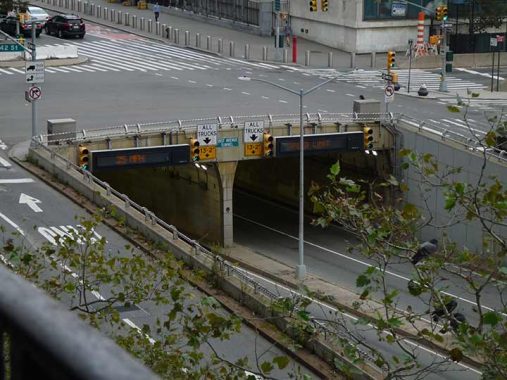
1st Avenue Tunnel
The United Nations complex opened in 1950 on a former slaughterhouse and warehouse district along 1st Avenue between East 41st and 47th Streets and immediately began attracting additional idling traffic from tour buses and other vehicles. So that “regular” traffic could proceed up 1st Avenue—northbound exclusively, as it opened in 1953, two years after 1st Avenue was made one-way northbound. The interior is a no-frills affair as with most tunnels, as seen on Street View.
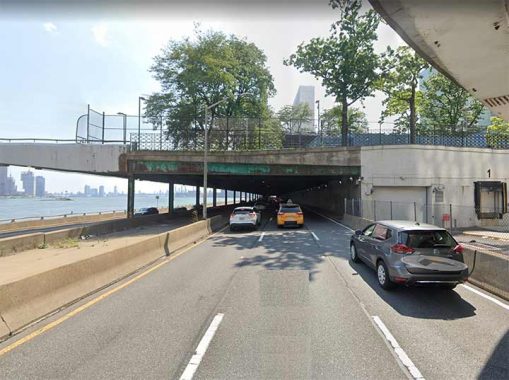
United Nations Tunnel
Speaking of the United Nations, the section of the Franklin D. Roosevelt Drive that passes beneath United Nations property along the East River is known on maps as the “United Nations Tunnel” but since it’s open on the east side, it’s not strictly speaking a tunnel.
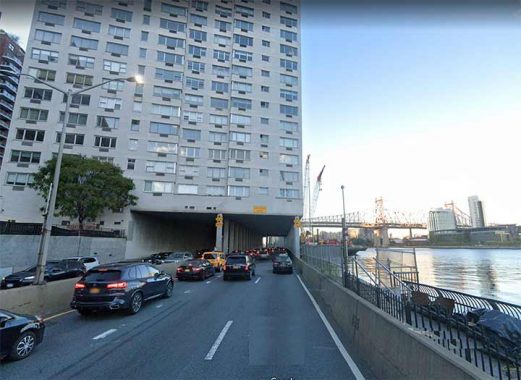
Sutton Place Underpass
The FDR enters yet another underpass between East 53rd and 61st Streets as some luxury high rise apartment buildings facing Sutton Place have been placed on a platform above it.
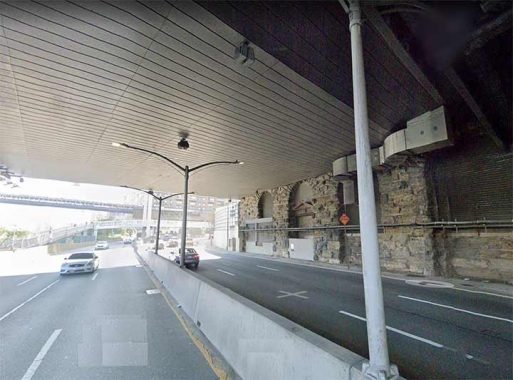
Rockefeller University Underpass
The FDR Drive is shadowed once more between East 63rd and 71st Streets by Rockefeller University and NY Presbyterian Hospital, some of whose buildings are platformed over the roadway. Toward the south end, there are some unusual lampposts that bring back the thin mast brackets seen on lampposts installed in the 1950s. (I’d bring them back fulltime!)
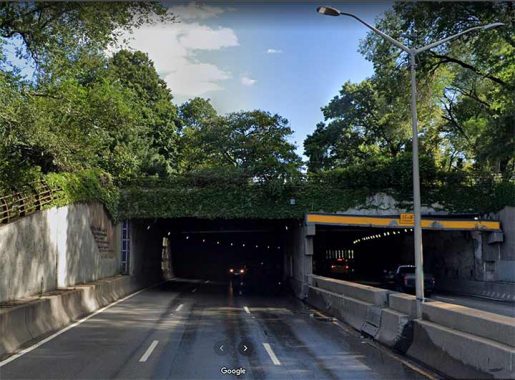
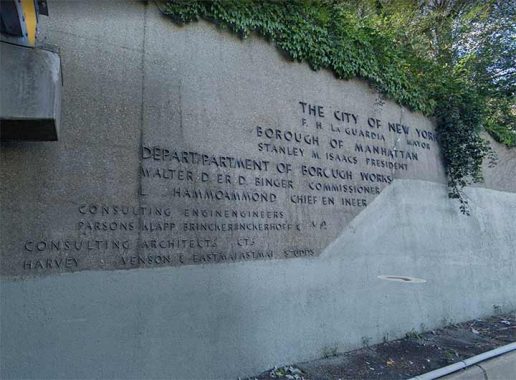
Gracie Mansion Tunnel
The FDR Drive enters another fairly lengthy cut beneath Carl Schurz Park and Gracie Mansion between East 83rd and 90th Streets that become a “true” tunnel at its north end. Unusually, it actually has a pair of signs in metal letters on each side at the north tunnel mouth, showing Fiorello LaGuardia and the other engineers that built the tunnel. These signs are, of course, not meant to be read by passing motorists but by whoever is using park paths above them. They haven’t been maintained and the letters are dropping off.
I haven’t really explored the East River walkway much in this realm, and I really should.
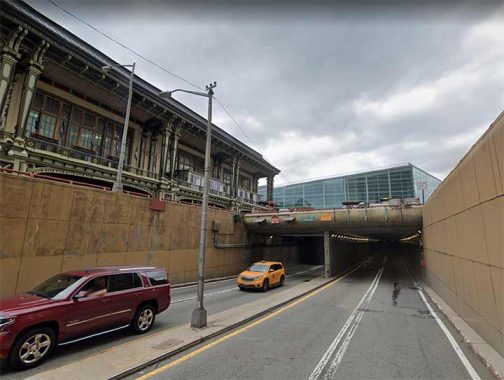
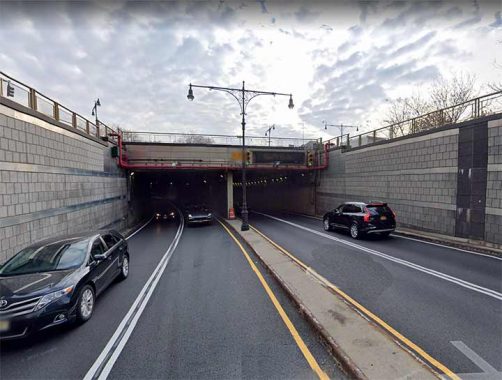
Battery Park Underpass
The roadway connecting The East River Drive (street signs only identify it as “FDR Drive” north of Montgomery Street) and West Street (formerly the elevated West Side Highway/Miller Highway) is known as the “Battery Park Underpass” even though it’s a true tunnel, running under the park’s west side. It was built between 1949 and 1951 just after the elevated FDR Drive opened along the East River. Various proposals to extend it north, replacing the viaduct, have petered out over the years.
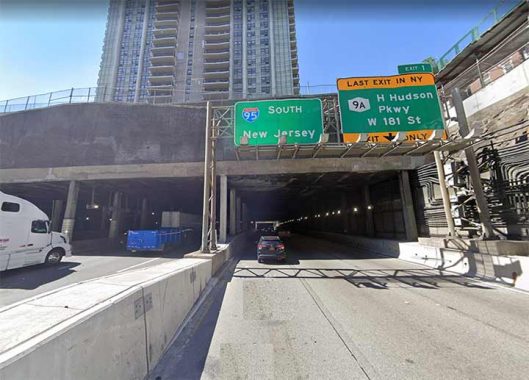
Trans-Manhattan Expressway Tunnels
The Trans-Manhattan Expressway is the shortest expressway in NYC, given the narrow width of the island at the point of passage. It was completed in 1952 and connects the Cross-Bronx Expressway with the George Washington Bridge. At several points, high rise apartment buildings were placed on platforms above it, creating de facto tunnels.
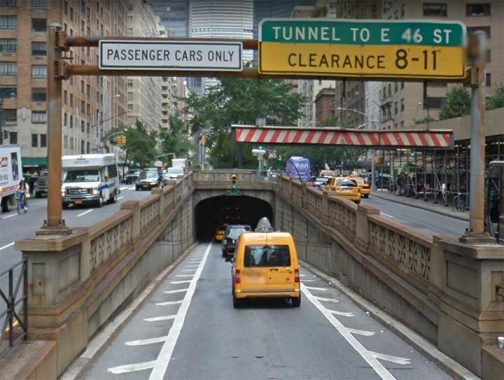
Park Avenue Tunnel
Motorists know all about the Park Avenue Tunnel, which runs beneath the avenue between 33rd and 40th Streets, but few pedestrians ever see it. It was built in 1834 as an open cut for the New York & Harlem Railroad (NY&H) which ran both steam engines and horsecars, and the cut was bridged over in 1850, creating the tunnel — one of NYC’s oldest by far the oldest shown on this page. The tunnel has carried trolley tracks, two-way traffic, and now northbound auto traffic.
The oldest tunnel of any kind in Manhattan is the Mount Prospect Tunnel opened in 1837. It now forms the center two tracks of Metro North from 92nd St to 94th St, under Park Ave. The tunnel north and south of it, and the one-track tunnels on each side of it, were added in 1873-1875, but the Mount Prospect Tunnel was left in place.

Periodically the Park avenue Tunnel is open to pedestrians during the Summer Streets event, three Sundays in August, when Lafayette Street/4th/Park Avenues ban motorized traffic from Foley Square north to East 72nd Street. In 2013, an art exhibit featured Rafael Lozano-Hemmer‘s Voice Tunnel installation, in which visitors could record a short message that would be played back continuously from speakers along the tunnel walls.
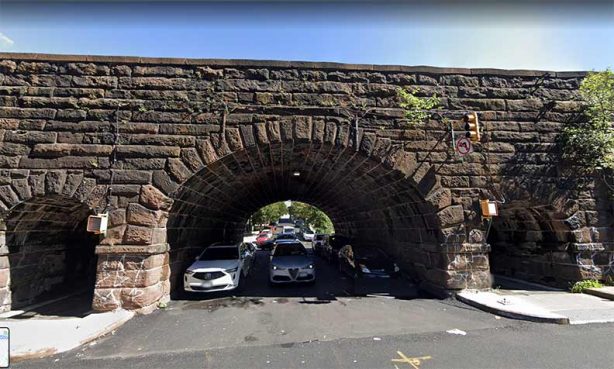
New York Central viaducts
Park Avenue is probably the most unusual of any north-south Manhattan avenue. Formerly 4th Avenue all the way north, its name was changed to Park avenue, or Park Avenue South below East 32nd, in a bit of wishcasting as north of Grand Central Terminal it once hosted a vast, smoke belching railyard. Eventually the New York Central and its predecessors were electrified and tracks placed in a tunnel from East 42nd to 97th Streets. North of that, the railroad was placed on a viaduct, and cross streets were bridged under it in these structures that resemble very short brick tunnels. The roadway is under one arch, and each sidewalk also get an arch.
In the Bronx, the railroad was placed in an open cut. The streets on either side of the cut were renamed “Park Avenue” in the 1800s. Also, quite unusually, in 1919, Park Avenue was placed on a viaduct of its own that skirted around Grand Central Terminal.

Adam Clayton Powell Connection
Adam Clayton Powell Boulevard, a.k.a. 7th Avenue, runs down a ramp from West 152nd Street that brings the roadway alongside the Harlem River Drive, connecting it with the section of West 155th Street that runs beneath the viaduct that runs to the Macombs Dam Bridge.
The ramp is accompanied by a set of antique lampposts that received new post top lamps around 2012.

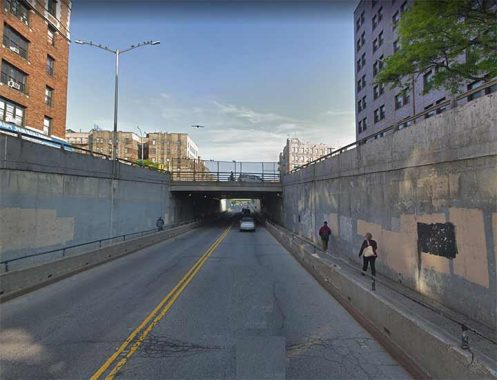
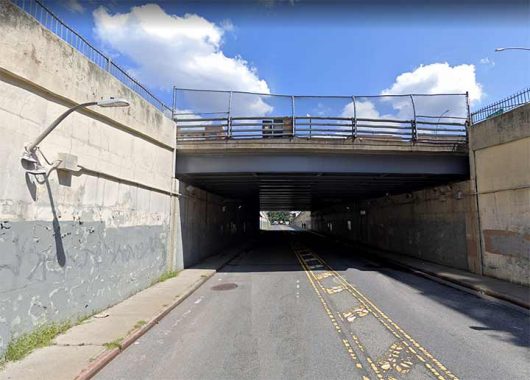
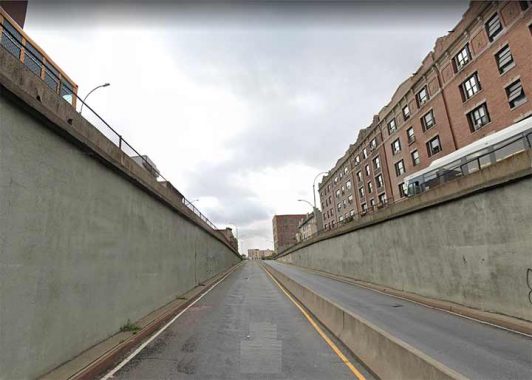
Grand Concourse Underjumps
A short time ago FNY profiled the Arches of the Concourse which take the great road over local streets in hilly areas of the mid-Bronx. There are also a number of cross streets that underjump the Grand Concourse, for traffic that wants to cross it in a no fuss no muss fashion. My suspicion is that these underjumps were originally built to accommodate trolley tracks. As you can see, some admit pedestrians on sidewalks, some do not.
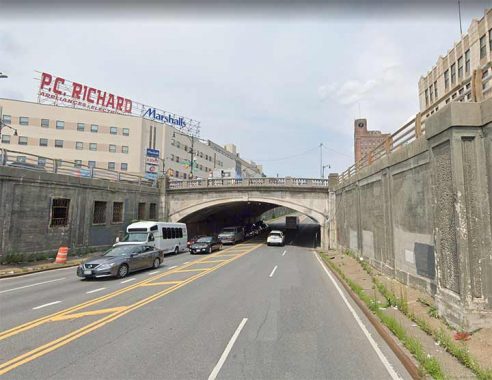
Fordham Road-Grand Concourse Underjump
Eleven lanes wide from 161st Street north to Mosholu, the Grand Boulevard and Concourse (shortened to Grand Concourse for the benefit of sign makers and cabbies) was conceived by engineer Louis Risse in 1870 and was built, from 161st Street north, in 1909. In 1927, it absorbed Mott Avenue, which ran from 138th north to 161st, and the older street was widened. The Grand Concourse became the Bronx’s showpiece as the Bronx Borough Hall, Yankee Stadium, and an array of elegant apartment buildings were constructed along its length.
Unless you are a motorist using the GC frequently you are probably unaware that East Fordham Road is bridged over it in an arch structure probably going back to the GC’s origins in 1909. The central four lanes bypass the busy intersection completely. In other intersections, lanes of Kingsbridge Road and East 204th, among others, pass under the Concourse, but this is the only case in which a road is bridged over it.
Here, at left, we see the former Alexander’s Department Store, the flagship in a chain of stores founded by George Farkas in 1928 and named for his deceased father. The Fordham Road store opened in 1933 and closed in 1992. The building is home to electronics chain P.C. Richard and clothing retailer Marshall’s.
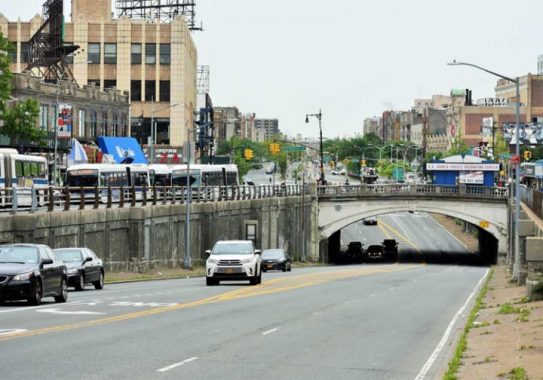
Looking south toward the Fordham Road Bridge. At left here is the Wagner Building, which on November 5, 1960 was the site of a campaign speech by John F. Kennedy, a few days before he beat Richard Nixon. As a boy in the 1920s, Kennedy had resided in a mansion with his family at Independence Avenue and West 232nd Street in Riverdale.
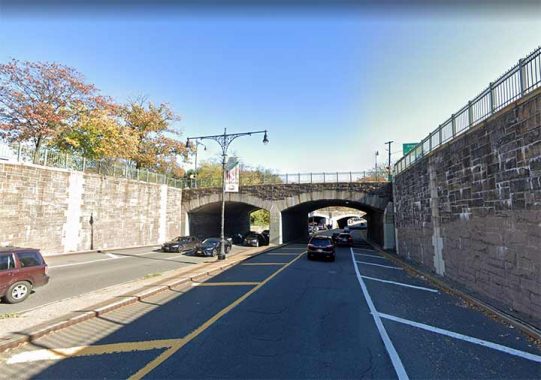
Fordham Road-Southern Boulevard Underjump
Traffic engineers also decided to “underjump” Fordham Road beneath Crotona Avenue and Southern Boulevard near Bronx Park, where it becomes Pelham Parkway.
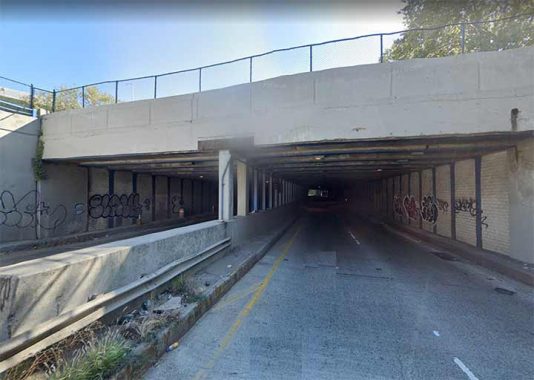
Bruckner Boulevard Tunnels
In Mott Haven, a pair of tunnels bring east and westbound Bruckner Boulevard tunnels under the spaghetti ramps connecting the Bruckner Expressway and the Triborough Bridge.
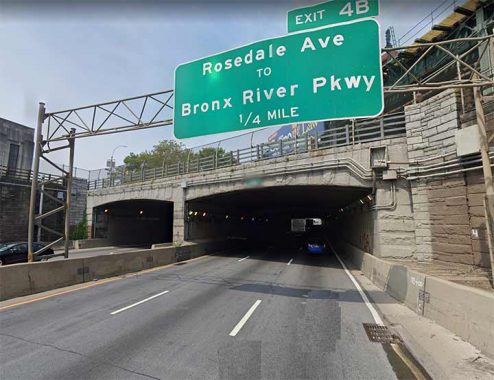
Cross-Bronx Crossing
Like it or hate it, the Cross Bronx Expressway is a marvel of engineering as its builders had to redirect underground conduits such as sewers and power conduits, as well as navigate deep valleys and inclines to build the road connecting the Hamilton and Throgs Neck Bridges in the 1950s and 1960s. Hugh Grant Circle, where the CBE meets Westchester Avenue and its el, was another challenge. Here, the CBE tunnels under both avenue and elevated.
The Cross Bronx also has to tunnel under Prospect Playground and Jerome Avenue.
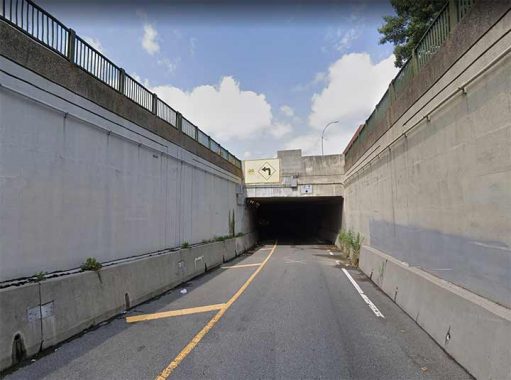
BQE-Queens Boulevard tunnel
Queens has a number of tunnels and open cuts, including quite a few under the Long Island Rail Road main line in Jamaica. This one is a very short tunnel westbound from Queens Boulevard at 65th Place that connects to the southbound Brooklyn-Queens Expressway.

BQE-Broadway Tunnel
The Brooklyn-Queens Expressway forms an undefended border between Woodside and Jackson Heights as it travels north-south. It tunnel; beneath the rather wide X-shaped intersection of Broadway and 37th Avenue.
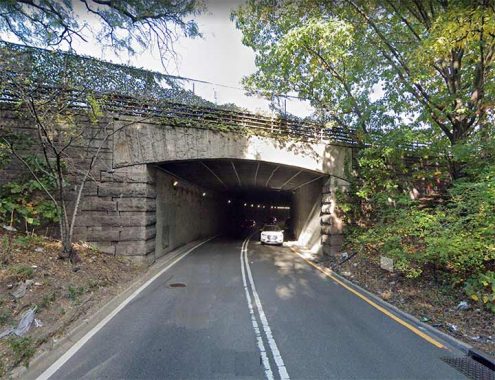
BQE-Grand Central Parkway Tunnel
Westbound traffic on the Grand Central Parkway wishing to transfer to the eastern leg of the Brooklyn-Queens Expressway southbound along the east side of St. Michael’s Cemetery travels through this handsome granite-blocked tunnel.
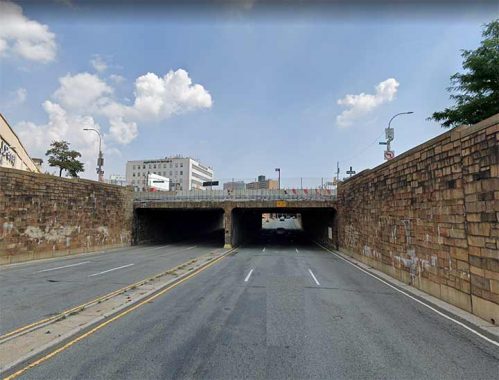
Woodhaven Boulevard – Long Island Expressway Underpass
In the 1930s, the middle lanes of Queens Boulevard were depressed in an open cut to make it easier for motorists to avoid both busy Woodhaven Boulevard and Nassau Boulevard, the road that eventually became the Long Island (Horace Harding) Expressway. Unlike other open cuts on this page, more esthetic care was taken to make the side walls attractive.
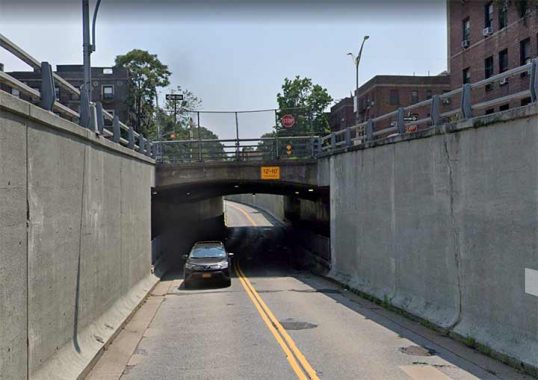
Austin Street Crossing
When the Interborough-Jackie Robinson Parkway was extended into Forest Hills in the 1930s, traffic engineers vouchsafed Austin Street a convenient passage beneath it.
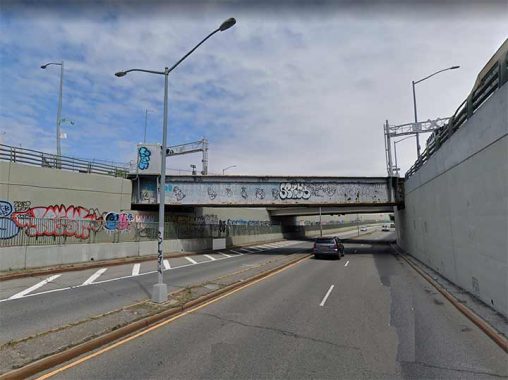
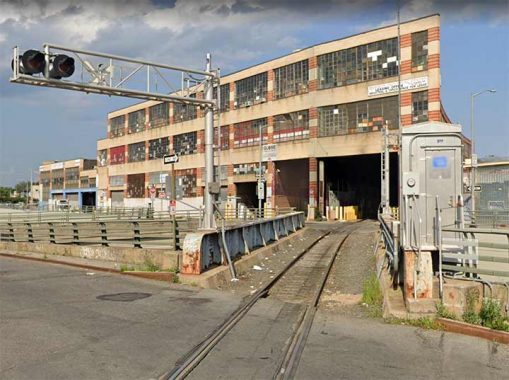
Flushing Avenue Railroad Underpass
Flushing Avenue, which runs from the Brooklyn Navy Yard to Maspeth, has to get around both the Long Island Rail Road freight-only Bushwick and Montauk branches. To do so, it enters an open cut and briefly becomes a de facto Flushing Expressway, with an uninterrupted run between 54th and 60th Streets.
Unusually, the “service roads” are allowed to cross the Bushwick tracks, seen here, but not the Montauk Tracks; the only through route is the open cut.
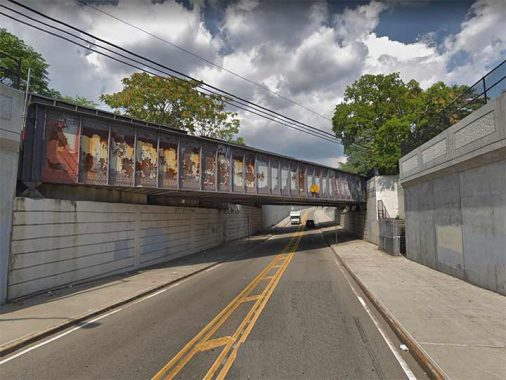
Cooper Avenue Underjump
A few miles to the east, Cooper Avenue in Glendale is in the same boat as it has to get by the surface Montauk LIRR branch without a grade crossing; thus, it enters this open cut while its “service roads” above it are stopped by the tracks.
Have I missed a few tunnels or unusual open cuts? Comments are open
As always, “comment…as you see fit.” I earn a small payment when you click on any ad on the site.
1/1/22

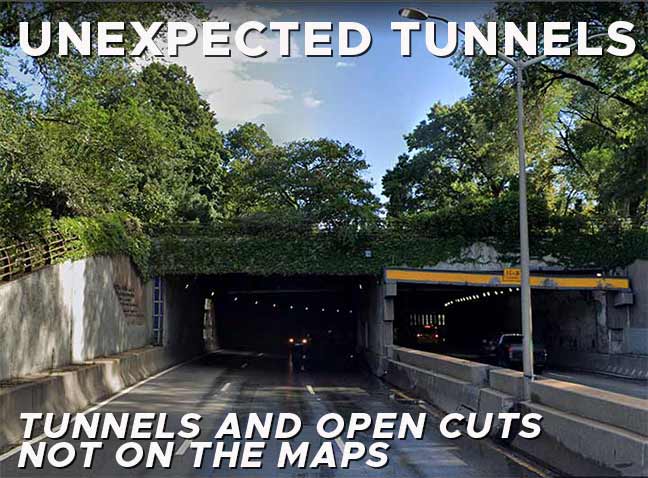
47 comments
Here are some others.
Union Turnpike/Jackie Robinson Pkwy tunnel under Queens Boulevard.
Main street entrance/exit to Van Wyck Expy under Queens Boulevard.
CSX rail tunnel in Middle Village.
I plan on adding those except the rail tunnel, which is a different bird entirely.
That should be a separate topic, there’s a ton of those. Like the Bay Ridge-St. George tunnel that starts under Owls Head. Or the hundreds of others
Re Jackie Robinson tunnel at Queens Blvd: for me, at 18 years old or 60, still the most terrifying stretch on a road full of them…..
I haven’t driven that stretch in 20 years and it still makes me break out into a sweat just thinking about it. The cemetery curves were no problem compared to this.
I’ve been on the Jackie Robinson Parkway only once, in 1982, and yet I still remember it 40 years later. I was in a cab going from Albert Einstein med school in the Bronx to Downstate Medical Center in Brooklyn for grad school interviews. The cab driver seemed to want to show off his driving skills to an out-of-towner. I couldn’t believe how narrow the tunnels were and how close I was to their walls. I moved to the center of the back seat. The cabbie exclaimed, “I love driving the Interboro Parkway!” and proceeded to throw me to and fro on the back seat on the banked curves. It was actually a relief to drive through the burned out neighborhoods of 1984 Brooklyn compared with riding on the Interboro!
Oh, how could we forget the I-95 GWB approach tunnel under the apartments in Washington Heights.
The Bedford Park Blvd underjump also features an entrance the B/D station, as does Kingsbridge Rd
Google maps kind of acknowledges both exits by placing the little blue arrows that signify a subway exit in the middle of Grand Concourse with no explanation.
https://www.google.com/maps/@40.8722111,-73.8879349,3a,75y,90t/data=!3m6!1e1!3m4!1sqlG8D_5mMFb220aeFCV7gQ!2e0!7i16384!8i8192!5m1!1e2
https://www.google.com/maps/@40.8660361,-73.8942167,3a,75y,90t/data=!3m6!1e1!3m4!1s6xkejcbATISGHWdx6RV4yw!2e0!7i16384!8i8192!5m1!1e2
Excellent!
Trolleys definitely ran through the Kingsbridge Road “Underjump” beneath the Concourse until 1948 when they were replaced by busses. You can find a video on YouTube of trolleys going back and forth and there are stills too. The subway tunnel for the D train ran just under the roadway of the Concourse but the under jump for Kingsbridge Road had a steep dip in the middle to carry it under both, so subway trains rumbled above auto traffic. Westbound trolleys and later busses stopped in the middle of the tunnel at an underground entrance to the subway station, though rising crime rates later made that dangerous so the westbound busses were routed along the service road. Trolleys heading east toward Fordham Road never stopped in the tunnel but ran straight through and emerged next to Poe Park. Hence eastbound busses always took the service road. As a kid I would wait at the next stop at Kingsbridge Road and 192 st/Valentine Avenue.
I”ve never heard the term “underjump” before – I like it! I have two more to add, if they meet your criteria, since they are more open. But the center lanes of the Grand Concourse itself do “underjump” E. Fordham Rd., and not far to the east of that, the center lanes of E. Fordham Rd. underjump the busy intersection with Crotona Ave. and Southern Blvd., where they all meet the Bronx Zoo and the Botanic Garden. In each case, even calling them an open cut might be a stretch, but they do dip below street grade level. Thanks, and keep up the good work!
With regard to the Grand Concourse underjumps, the ones pictured at Kingsbridge Road and Tremont Avenue once carried trolleys and for many years, the replacement buses. Today the buses use the outer lanes and stop at the top of the crest that carries the Grand Concourse – most likely for security reasons and also to facilitate transfers to the major north-south bus routes on the Concourse.
There are additional east-west Bronx streets that dive under the Concourse in similar tunnels – going north to south they are Burnside Avenue, 170th Street, 167th Street, and 161st Street. Except for 170th, all originally hosted crosstown trolleys that are now bus routes; 170th was always a bus route (still is).
The tunnels at 170th and 167th once had stairs to the IND D train stations above, but those have been closed for security reasons. At Bedford Park once can still enter the D train from the underpass.
At Fordham Road the treatment is the opposite – the Concourse main (middle) roadway dips under Fordham in an underpass. The result is that the D train station below it is partially split in two by the roadway above, clearly visible on the downtown platform.
Agree with Jerry on that. The JRP tunnel under Queens Boulevard. The downhill, narrow lanes and the slight dog-leg make it unnerving
When you come out of the BBT on the Brooklyn side there is a tunnel that I have never entered that loops around to the BQE East(north-ish). Also a quick tunnel from southbound West st under “something” before the merge for the BBT
East 161 Street underjumps Eagle Avenue up the hill from St. Ann’s Avenue to Cauldwell Avenue.
I would normally be like “but no love for Staten Island?” but in this case, there’s good reason for omitting Richmond Borough…there are no tunnels! Well, except for that short stretch of B&O-Staten Island Railway tunnel approaching St. George Terminal. Otherwise, nary a tunnel in the entire borough. Funny looking at the pics above how the Upper Manhattan-Outer Borough tunnels are not nearly as well maintained as the tunnels in Lower Manhattan. Adam Clayton Powell, Jr must be spinning in his grave looking at the sad state of his tunnel!
There is a rail tunnel under what was the Coast Guard base St. George, S.I. By law any private RR could not cross Federal property. Most of the property is now the lighthouse museum.
Not an NYC tunnel, but close: when taking a bus from PABT to Hoboken in the 90s and early 00s, I would notice that right after the bus surfaced in Weehawken it would go through a second ancillary tunnel underneath Boulevard East, I think it was. Right after it surfaced again on the way south to Hoboken, it would pass a small one-car garage on a private lot, technically on Boulevard East but actually on the tunnel mouth that was spitting out cars and buses 24-7. This seemed to me like the unlikeliest and most dangerous location for a garage imaginable. Anyone backing out onto the roadway would have to be insane or have nerves of steel and superhuman driving skills. I have not taken that bus in 15 or so years but wonder if the garage is still there. I never saw anyone use it, but if I had, an accident involving my bus and the car would have probably resulted.
How about the tunnels in the Central Park transverses? They’re considerably longer than wide, so they feel like tunnels. Or the pedestrian tunnels under the West Side Highway in Riverside Park? E.g., 73rd St.
Also I think there is a tunnel going from the Henry Hudson into the Cloisters? And I could swear I drove through a tunnel in Riverdale somewhere but no idea where and could totally be making that up.
Close call but I consider them bridges (East and West Drives over the transverse roads) more than tunnels.
That road from northbound HHP to the Cloisters is one of the really amazing gems in the entire city! Not a tunnel, but the high rocky hill was blasted through to create a lane for cars, with a beautiful archway built over. It’s short in length, but with very high sides. I’m pretty familiar with Riverdale, and can’t think of any tunnel or cut. But I also couldn’t remember the Trans-Manhattan Expressway, and I live right nearby!!
Hard one to find. Austin Street underpass by Union Tpke. and Jackie Robinson pkwy. In Forest Hills.
Ah yes, the ” I-95 GWB approach tunnel”, officially the Trans-Manhattan Expressway, one of the shortest expressways anywhere, and the two blocks of residences above known to many as Monoxide Towers. Less well known is the pair of tunnels that once connected the bridge and the Harlem River Drive approach. Find an old Hagstrom for those, under 178th and 179th I think, which would put them on each side of the TMEx (to give the Trans-Manhattan Expressway a nickname it hardly needs). I wonder what’s in those tunnels now. That is truly Forgotten New York.
The two tunnels beneath Washington Heights, built to carry GW Bridge traffic to/from the Harlem River Drive and Amsterdam Avenue, pre-dated the I-95 construction and have an interesting history. The first one opened in 1940 under W 178th St. and was two ways (one lane each way). A second one for westbound traffic under W 179th opened in 1952 with two more lanes, allowing the original one to become one way eastbound. Both tunnels were, of course, made redundant by the I-95 behemoth under “the apartments”, as so many radio listeners hear every day. Believe the west end of each tunnel is still used to store Port Authority service vehicles.
What about the abandon train tunnel under Atlantic Ave in Brooklyn? They used to give tours there.
This page is about roadway tunnels.
I still marvel at the crumbling feat of the underpasses beneath the Brooklyn promenade. The southbound underpass is definitely more creepy but I always loved the sun reflecting off the Watchtower properties. The northbound underpass holds more nostalgia for me as it makes it turn around Cadman Plaza I always think about the strollers up on the promenade taking in the sights. Then I fondly think of Cher kicking the can in Moonstruck.
I had always thought the 1st Avenue tunnel by the UN was built while 1st Av. was still a two-way, since the depressed roadway has a median.
I remember a time when some areas of the street had a median, and the one-way traffic could keep left or right. Must have been a leftover from the two-way days.
Astonishing and informative collection! Bravo. Really fine work here.
In the Bronx there is a tunnel you can use in both directions but mainly use it in the northbound/eastbound direction along Bruckner Boulevard from St. Ann’s Avenue to E. 136th Street mainly to connect from the Willis Avenue Bridge to the Bruckner Expressway entrance. Also is a small short tunnel more of an underpass further north along connecting the eastbound Cross Bronx Expressway service road to Bruckner Boulevard. Also there are other tunnels along the Cross Bronx Expressway itself (one under Hugh Grant Circle in Parkchester, one near Crotona Park, and of course the one under the Grand Concourse. Also another tunnel in Queens connecting the Grand Central Parkway West with the BQE (Exit 4).
Doesn’t Church Ave in Kensington have tunnels where the old trolleys went?
They’re down there but long covered over.
The Park Avenue Viaduct also goes through a tunnel, as it literally runs through the Helmsley building before continuing around the MetLife (formerly Pan Am) building and Grand Central Terminal.
There’s a 3/4-mile long freight-only rail tunnel in East New York. While the tunnel was built for 4 tracks, only 1 track is in use.
Bronx Boulevard undercuts Gun Hill Road. I’m not sure of your criteria for inclusion, but I thought I’d mention it.
I see that as more of a Gunhill Road bridge.
There is a very large tunnel in Brooklyn where East New York Ave passes under Atlantic Ave and not one, but two elevations of subway lines:
https://www.google.com/maps/@40.6755436,-73.903446,3a,88.2y,67.74h,89.26t/data=!3m6!1e1!3m4!1sm3Dad_ZuHUjW-hV23N0doQ!2e0!7i16384!8i8192?hl=en
There are probably countless others in the five boroughs.
One of my favorites is where both the Jackie Robinson Parkway AND Union Turnpike pass both under Queens Blvd and over the E & F subway line and stations. The subway station is actually visible on at least one if not both sides of the tunnel. My recollection from when I was a young boy (1960s), that one could drive up on Union Turnpike, within the tunnel, and pull to the side to discharge passengers to the subway station. Maybe it was just my imagination?
https://www.google.com/maps/@40.7141742,-73.8313557,3a,75y,70.19h,83.26t/data=!3m6!1e1!3m4!1snTKlUjLLRz2maAuRKj3bog!2e0!7i16384!8i8192?hl=en
Not your imagination. Was definitely possible to drop off people at the IND E & F at Union Tpke. Station. I remember doing it a number of times in the sixties and seventies. Closed around 1980 – not 100% sure.
For some reason I don’t consider the ones on the FDR Drive to really be tunnels seeing that it’s just parts where platforms were built to place something over it be it a building or a park, plus the northbound side isn’t covered, which does allow you to see the East River and what’s across it.
The page also features open cuts and other unusual configurations.
Former Kennedy residence is at West 252 St. and Independence Ave.
Great and interesting post, Kevin.. Last summer, I was with my Donna on a long Maspeth recon and we went down the steps from Street level to the Cooper Avenue Underjump. There was so much poop and glass there that I tried to leap over some poop, always a fun event, and got a huge piece of glass in my sports sandal. Saved by an inch of hard rubber. I was close to gashing my foot on glass a good 6 miles from my Astoria home. In your recons of such remote areas, I am sure you have seen the worst of things, as I have. Excellent piece, keep it going. Your friend, Rich Melnick
This is why I do not wear sandals.
The little children would be frightened by my toenails.
Since we’re talking about tunnels, there was supposed to be a highway where the West Side Highway is now known as the Westway that was supposed to replace the Miller Highway when it was to be taken down. If it got built, it would have been similar to the Big Dig in Boston. There were two main reasons to why it didn’t get built. The first one had to do with its costs that made it feel like a major boondoggle. The second one had to do with environmental issues especially with what was used to keep it sound. As a result, the idea was scrapped and we wound up with the street level highway we see today below 57th Street.
I believe there is at least one tunnel, maybe even two, on the 79th Street Traverse through Central Park. I feel like there might be others in the park as well. Perhaps with that in mind a future post on Pedestrian Tunnels is in order.
My older siblings and I don’t know what a type shop is…